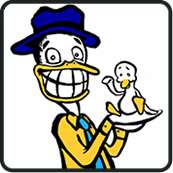Each team has 11 players on the field. As such, there are 11 positions.
The most well-known position is the goalkeeper; each team has only one, and the rules for the goalie are slightly different than for the other players. The most important distinction is that a goalkeeper is the only player who can touch the ball with his hands (for the sake of easy reading, let's assume it's a boy goalkeeper). In fact, since goalkeepers are in charge of preventing the ball from entering their goal, they do an awful lot of touching with the hands. There are a few limitations on all this handtouching: first, a goalie cannot use his hands outside of an area called the penalty box, which is a box 18 yards deep affixed to his goal line; second, the goalie cannot use his hands if the ball is passed to him intentionally by a teammate.
In front of the goalkeeper is a row of four players who are defenders. On the left and right are the left full back and right full back, and between them is a center back. The fourth defender often plays slightly behind the center back and is called the sweeper, because his job is to sweep up any defensive work that the three others cannot handle.
In front of the defense is the midfield, which refers collectively to the three of four players who operate in the middle of the field between defenders and attackers. These positions are called left-half, center-half, and right-half. These players are responsible for defending when needed, and for winning the ball in the many skirmishes that occur in the middle of the field. When the ball falls into their team's possession, midfielders are responsible for orchestrating the attack by passing amongst themselves and ultimately giving the ball to forwards who may be well-positioned to score.
The front line consists of forwards or attackers. On the sides are the left-wing and right-wing, and in the center are the center-forwards or strikers. These players are known for their speed and ability to score goals. The wingers are often used to cross the ball with accuracy into the middle of the field where the strikers should be positioned to take a shot at the goal. Strikers are renowned for their ability to score goals via foot, chest, or head.
Unlike almost any other American sport, soccer players cannot be substituted freely. In a typical match, only three players are allowed be substituted throughout the entire course of a game, which places a premium on stamina. Many substitutions are used late in the game so that the team that is behind can put in an extra striker (by replacing a defensive player) to press for that needed goal. Similarly, the team that is ahead can load up on fresh defenders to help preserve their lead.
Although a conventional configuration of the eleven players is to have 1 goalkeeper, 4 defenders, 3 midfielders, and 3 forwards, these positions are eminently flexible and there are no restrictions on movement. That means a team that needs to score can switch to a 1-3-3-4 configuration, and one that wants to defend a lead may switch to a 1-4-4-2 format. Again, these variations should not be taken too literally, since strikers may be called to defend, with their skill at getting to a ball obviously a useful asset on either end of the field.
SoYouWanna know more? Check out our full-length article SYW learn the basics of soccer?

